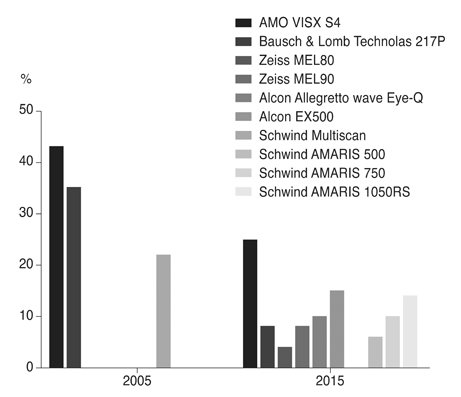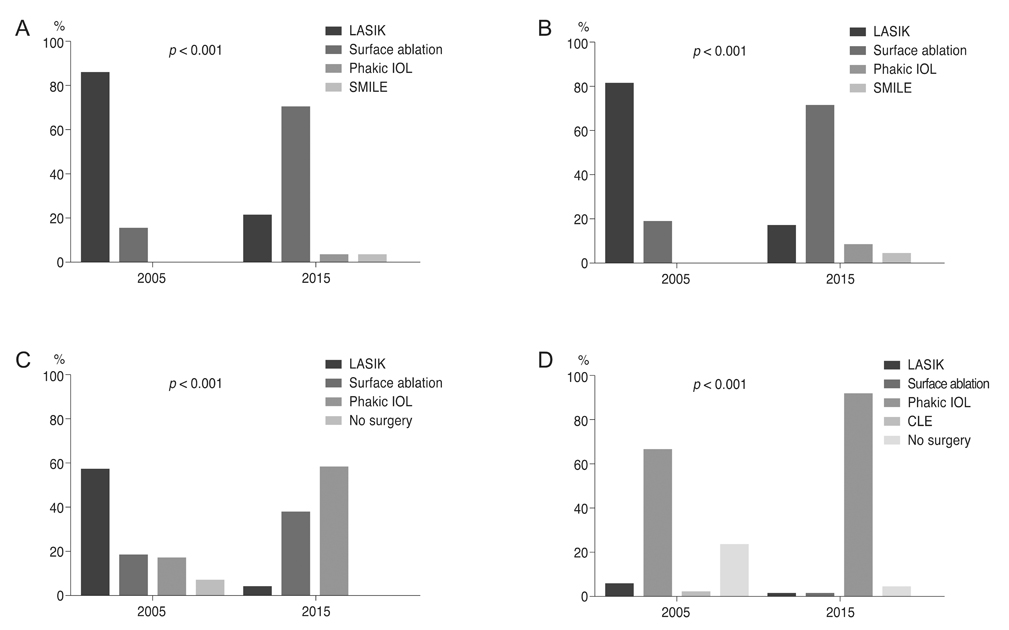Korean J Ophthalmol.
2018 Feb;32(1):8-15. 10.3341/kjo.2017.0010.
Investigation of the Changes in Refractive Surgery Trends in Korea
- Affiliations
-
- 1Department of Ophthalmology, Gil Medical Center, Gachon University, Incheon, Korea. amidfree@gilhospital.com
- 2Yeonsu Kim's Eye Clinic, Incheon, Korea.
- KMID: 2402714
- DOI: http://doi.org/10.3341/kjo.2017.0010
Abstract
- PURPOSE
To evaluate changes in clinical practice in the field of refractive surgery in Korea over the past 10 years.
METHODS
A survey consisting of 59 multiple-choice questions regarding the preferred types of refractive surgery, excimer laser machine, and presbyopia surgery was mailed to 742 members of the Korean Society of Cataract and Refractive Surgery in January 2016, and 50 members responded to the survey. These data were compared with the 2005 or 2007 survey results.
RESULTS
The majority of respondents were in their 40s (54%), and the average number of refractive surgeries performed in one month was 53. The most commonly used excimer laser machine was the VISX S4 in both 2005 (32%) and 2015 (25%); however, a greater variety of machines (EX500 [18%], Allegretto wave Eye-Q [13%], AMARIS 750 [10%]) were used in 2015. The preferred corneal refractive surgery in 2015 was surface ablation (40%), representing a significant increase in its popularity compared to 2005 (15%) (p < 0.001). The popularity of laser in situ keratomileusis (LASIK) surgery decreased to 20% in 2015 compared to 48% in 2005 (p < 0.001). Eighty percent of LASIK procedures in 2015 were performed using femtosecond laser. In 2015, surface ablation and phakic intraocular lens implantation were preferred for the treatment of myopia less than -8 diopters and more than -8 diopters, respectively. The proportion of respondents performing presbyopia surgery in 2015 (76%) was significantly increased from 2007 (30%) (p < 0.001).
CONCLUSIONS
Over the past decade, the most commonly performed corneal refractive surgery has changed from LASIK to surface ablation, and there has been a significant increase in the popularity of presbyopia surgery.
Keyword
MeSH Terms
Figure
Reference
-
1. Munnerlyn CR, Koons SJ, Marshall J. Photorefractive keratectomy: a technique for laser refractive surgery. J Cataract Refract Surg. 1988; 14:46–52.
Article2. Pallikaris IG, Papatzanaki ME, Siganos DS, Tsilimbaris MK. A corneal flap technique for laser in situ keratomileusis. Human studies. Arch Ophthalmol. 1991; 109:1699–1702.3. Camellin M. Laser epithelial keratomileusis for myopia. J Refract Surg. 2003; 19:666–670.
Article4. Shyn KH, Yoon SC. Refractive surgery 2005 in Korea. J Korean Ophthalmol Soc. 2008; 49:570–576.
Article5. Ku M, Shyn KH. 2006 Survey for KSCRS members: current trends in refractive surgery in Korea. J Korean Ophthalmol Soc. 2009; 50:182–188.6. Paik HJ, Song HJ, Shyn KH. 2007 Survey for K SCRS members: current trends in cataract surgery in Korea. J Korean Ophthalmol Soc. 2009; 50:1624–1631.7. Hong JP, Nam SM, Im CY, et al. Comparison of analgesic effect of preoperative topical diclofenac and ketorolac on postoperative pain after photorefractive keratectomy. J Cataract Refract Surg. 2014; 40:1689–1696.
Article8. Hansen RS, Lyhne N, Grauslund J, et al. Four-year to seven-year outcomes of advanced surface ablation with excimer laser for high myopia. Graefes Arch Clin Exp Ophthalmol. 2015; 253:1027–1033.
Article9. Duffey RJ, Leaming D. US trends in refractive surgery: 2015 ISRS survey [Internet]. Las Vegas: American Academy of Ophthalmology;2015. cited 2017 Nov 30. Available from: http://isrs.aao.org/Assets/61d6958b-696a-4888-b539-757156c28663/635839820892400000/2015-us-trends-survey-presentation-pdf.10. Hwang YH, Kim HK, Sohn YH, e t. C entral c orneal thickness in a Korean population: the Namil Study. Invest Ophthalmol Vis Sci. 2012; 53:6851–6855.11. Brandt JD, Beiser JA, Kass MA, Gordon MO. Central corneal thickness in the Ocular Hypertension Treatment Study (OHTS). Ophthalmology. 2001; 108:1779–1788.
Article12. Goker S, Er H, Kahvecioglu C. Laser in situ keratomileusis to correct hyperopia from +4.25 to +8.00 diopters. J Refract Surg. 1998; 14:26–30.
Article13. Geggel HS, Talley AR. Delayed onset keratectasia following laser in situ keratomileusis. J Cataract Refract Surg. 1999; 25:582–586.
Article14. Lyle WA, Jin GJ. Laser in situ keratomileusis with the VISX Star laser for myopia over -10.0 diopters. J Cataract Refract Surg. 2001; 27:1812–1822.
Article15. Fernandes P, Gonzalez-Meijome JM, Madrid-Costa D, et al. Implantable collamer posterior chamber intraocular lenses: a review of potential complications. J Refract Surg. 2011; 27:765–776.
Article16. Schmickler S, Bautista CP, Goes F, et al. Clinical evaluation of a multifocal aspheric diffractive intraocular lens. Br J Ophthalmol. 2013; 97:1560–1564.
Article17. Mendicute J, Kapp A, Levy P, et al. Evaluation of visual outcomes and patient satisfaction after implantation of a diffractive trifocal intraocular lens. J Cataract Refract Surg. 2016; 42:203–210.
Article18. Seyeddain O, Hohensinn M, Riha W, et al. Small-aperture corneal inlay for the correction of presbyopia: 3-year follow-up. J Cataract Refract Surg. 2012; 38:35–45.
Article19. Garza EB, Chayet A. Safety and efficacy of a hydrogel inlay with laser in situ keratomileusis to improve vision in myopic presbyopic patients: one-year results. J Cataract Refract Surg. 2015; 41:306–312.
Article
- Full Text Links
- Actions
-
Cited
- CITED
-
- Close
- Share
- Similar articles
-
- 2007 Survey for KSCRS Members: Current Trends in Refractive Surgery in Korea
- 2006 Survey for KSCRS Members: Current Trends in Refractive Surgery in Korea
- Refractive Surgery 2005 in Korea
- Cataract and Refractive Surgery in ; a Survey of KSCRS Members From 1995~2006
- 2003 Survey for KSCRS Members: Current Trends in Cataract and Refractive Surgery in Korea





